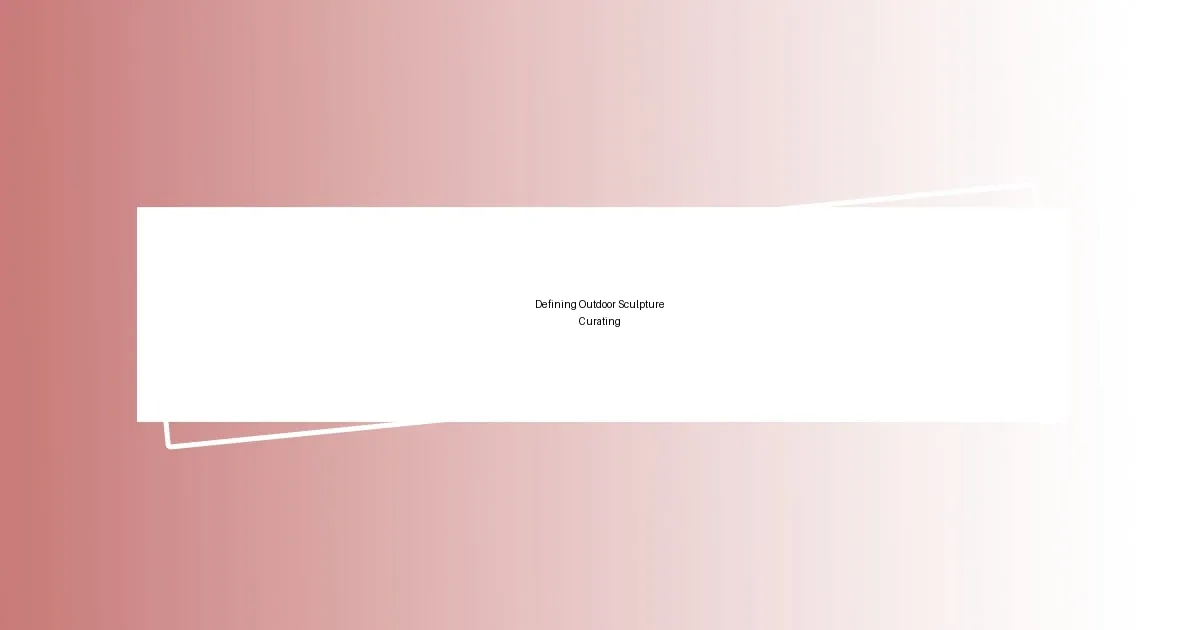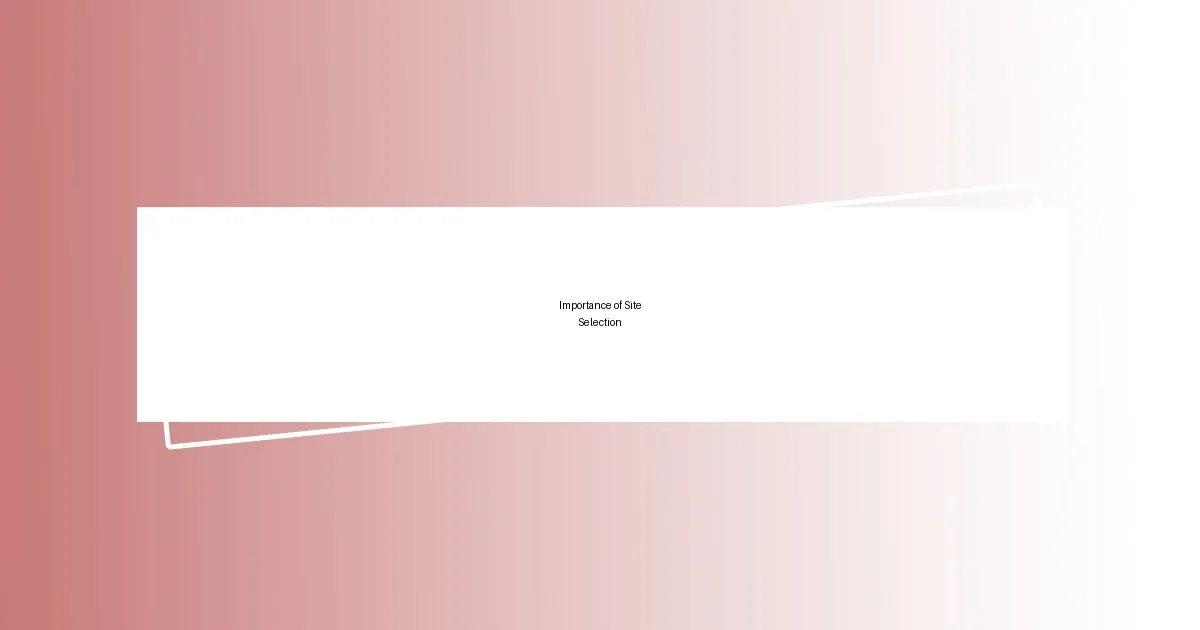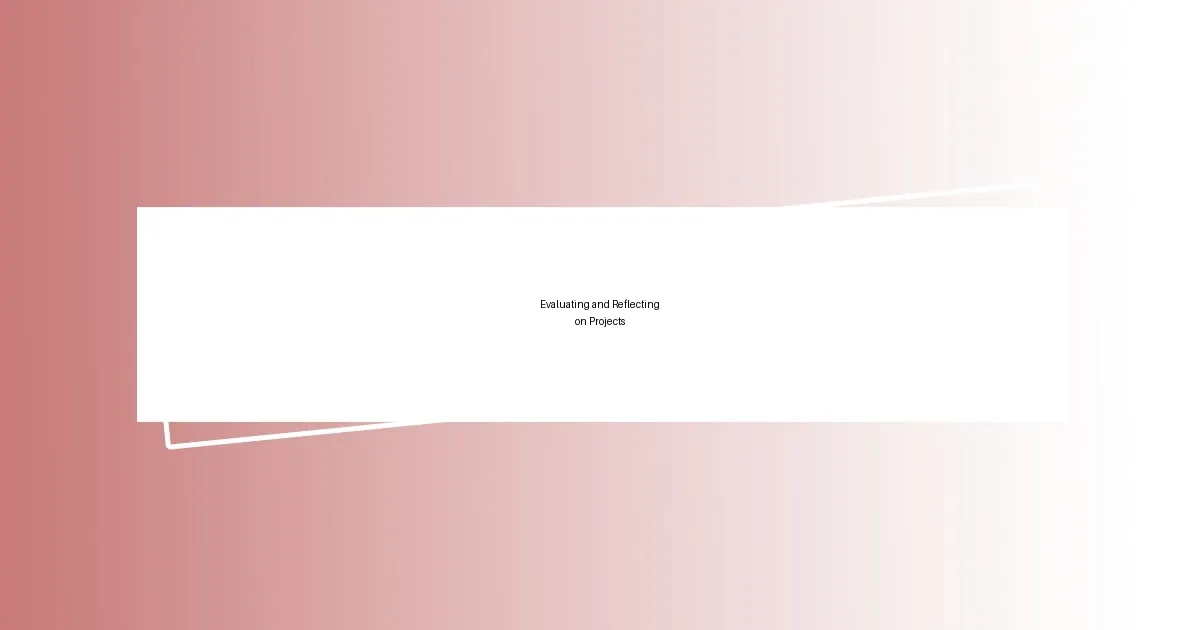Key takeaways:
- Outdoor sculpture curating requires a deep understanding of the site’s history, culture, and the community’s needs to create a meaningful experience.
- Site selection significantly influences the perception of artwork and visitor engagement, with attention to physical characteristics and cultural resonance being essential.
- Engagement with local artists and community members fosters collaboration and enriches the narrative of the exhibition, highlighting the importance of shared stories and experiences.
- Continuous evaluation and reflection after each exhibition allow for growth in curatorial practice, enhancing future projects based on feedback and insights gained.

Defining Outdoor Sculpture Curating
Outdoor sculpture curating is the intricate process of selecting and placing sculptures in open spaces to enhance the viewer’s experience. I remember the first time I stepped into a park filled with large-scale sculptures; the way they interacted with nature and the people around them was magical. Isn’t it fascinating how the right piece in a specific setting can create dialogue not only with the environment but also among the visitors?
Curating outdoor sculptures involves more than just choosing artworks; it requires a deep understanding of the site’s history, culture, and landscape. In one project, I found myself contemplating the exact placement of a modern piece near a historic building. How could I ensure that the past and present spoke to each other? It was a delicate balance that involved both artistic vision and careful planning.
Additionally, outdoor sculpture curating demands an awareness of the community’s needs and desires. I once facilitated a workshop where local artists showcased their work, and it struck me how crucial it is to engage with the community’s voices. Have you ever considered how a sculpture can reflect the identity of a neighborhood? It’s this kind of connection that can transform a simple display into a vibrant part of daily life.

Understanding the Curatorial Process
Understanding the curatorial process is essential for creating impactful outdoor sculpture exhibitions. I recall a project where I spent countless hours studying the environment and its surrounding community, realizing how vital it was to align the artwork with the local culture. That connection isn’t just beneficial; it’s necessary for fostering a sense of belonging and pride among residents.
- Research and Site Analysis: Thoroughly investigate the location’s history and cultural significance.
- Community Engagement: Host meetings to gather local input and ensure the sculptures resonate with residents.
- Selection Criteria: Define clear criteria for choosing artworks that complement the space and enhance visitor experience.
- Exhibition Planning: Plan the layout to encourage exploration and interaction, creating a natural flow throughout the space.
- Feedback Loop: Establish a process for collecting visitor feedback to continually refine future exhibitions.
I’ve learned that integrating community feedback not only enriches the curatorial process but also deepens my connection to the people who will experience the art. I feel energized when I see the joy an artwork brings or the conversations it sparks—it’s a reminder of why I fell in love with curating in the first place.

Importance of Site Selection
Site selection is a crucial aspect of outdoor sculpture curating that can dramatically influence both the perception of the artwork and the overall experience for visitors. I once chose an urban plaza for a vibrant, interactive piece, and the energy of passersby transformed the sculptures into a living installation. The site’s hustle-and-bustle added a dynamic layer, demonstrating how location can enhance viewer interaction and engagement.
Moreover, the physical characteristics of a site, such as accessibility, visibility, and safety, are vital considerations in this process. I vividly remember curating a series of sculptures in a scenic park where natural pathways guided the viewer’s journey. This thoughtfulness in how a piece is approached allows for storytelling through placement; each turn reveals new perspectives, encouraging visitors to engage with the works in a multi-faceted way.
Finally, the emotional and cultural resonance of a site can determine how effectively a sculpture communicates its intended message. I once exhibited a reflective piece in a community garden that encouraged personal introspection. The lush surroundings and tranquil atmosphere invited visitors not just to observe, but to contemplate, making the artwork touch their lives in a deeply emotional way.
| Factors in Site Selection | Impact on Experience |
|---|---|
| Physical Characteristics | Enhances accessibility and engagement |
| Cultural Resonance | Facilitates emotional connection and dialogue |
| Visitation Patterns | Influences audience interaction |

Engaging with Artists and Communities
Engaging with artists and communities is at the heart of what I strive to achieve as a curator. I remember a particular instance where I invited local artists to a brainstorming session for an upcoming exhibition. Their raw passion and unique perspectives sparked a sense of collaboration that transformed our initial ideas into something truly groundbreaking. This exchange is vital; it not only brings authenticity to the exhibition but also fosters a mutual respect and understanding among all parties involved. Have you ever felt that exhilarating moment when creative ideas collide? It’s electric.
There’s something incredibly rewarding about witnessing the way art can unite a community. On one project, we reached out to residents to share their stories and experiences, which became the foundation for several pieces in the exhibit. The emotional connection that blossomed from those conversations was palpable. I felt like I was piecing together a larger narrative that represented the community’s voice. It made me realize that engagement is not just about the installations themselves, but about the stories they tell and the relationships they build.
I often reflect on how important it is to create spaces for dialogue and collaboration. One time, during a community feedback event, I watched as families young and old gathered to share their thoughts on potential artworks. It was beautiful to see how art can ignite conversations about identity, history, and aspirations. These moments remind me that curating isn’t merely about displaying art; it’s about fostering a sense of belonging. How can we curate in a way that not just showcases art but also nurtures community ties? This ongoing dialogue is something I find deeply fulfilling and essential to my work.

Developing a Curatorial Vision
Developing a curatorial vision is not just a prerequisite for curating outdoor sculptures; it’s the very foundation upon which each exhibition stands. I recall the moment when I realized the importance of having a clear vision. While working on a thematic exhibition centered around nature’s fragility, I felt an overwhelming urge to convey a message that resonated far beyond the visuals. This clarity enabled me to select artists and pieces that echoed that theme harmoniously, creating a cohesive and powerful narrative for viewers to absorb.
Each artwork is like a piece of a puzzle, and finding how they fit together within the overarching vision is where the magic happens. I remember meticulously choosing a sculpture that seemingly contradicts its environment—a rugged, industrial piece amid gentle greenery. This juxtaposition sparked dialogue about man versus nature, encouraging observers to reflect. Have you ever seen something that made you question your surroundings? That’s the kind of engagement I aim for through my curatorial vision, inviting a deeper contemplation of our relationship with the world.
Sometimes, the process of developing this vision can be chaotic, filled with shifting ideas and inspirations. During one creative block, I took a long hike in the woods to clear my mind. Observing the interplay of light, shadow, and form around me sparked an epiphany about the interplay between sculpture and its environment. Suddenly, I had a renewed sense of direction. It made me ponder: how often do we seek inspiration in the natural world around us? Embracing those moments of clarity, even amidst chaos, is essential in crafting a vision that is not only personal but deeply resonant with the audience.

Planning and Executing Exhibitions
Planning an exhibition requires meticulous attention to detail. I remember the thrill of mapping out the layout of an outdoor space for a sculpture exhibition. It felt like a puzzle, trying to visualize how each piece would interact with the natural surroundings and how pathways would guide visitors through the experience. Have you ever laid out a space and felt the excitement build as you imagined the flow of people amidst the art? That anticipation is unmistakable.
Executing the exhibition is where everything comes together. I’ll never forget the palpable energy during installation week, with artists near their artworks, making final adjustments. There’s a unique camaraderie that develops in those moments. It’s as if everyone shares a common goal—to create something magical. That’s when I truly appreciate the diverse talents contributing to the exhibition. It’s like orchestrating a symphony of creativity; each voice, whether it be an artist or a community member, plays a vital role in the final performance.
Throughout my journey, I’ve learned that flexibility is crucial. I recall one rainy day while setting up a piece that required specific lighting conditions. As the clouds threatened our schedule, quick thinking became essential. We adapted on the fly, moving sculptures to utilize natural light as best we could. This experience taught me that sometimes, the most beautiful moments emerge from unforeseen challenges. How often do we find ourselves adjusting plans and discovering new possibilities? Flexibility not only enhances the execution but also fosters resilience—a lesson that continually enriches my curatorial practice.

Evaluating and Reflecting on Projects
Evaluating and reflecting on completed projects is where I truly connect the dots between intention and impact. After each exhibition, I find it invaluable to sit down and assess what worked and what didn’t. For instance, after a recent installation, I gathered feedback from visitors and artists alike. Their insights often reveal perspectives I hadn’t considered. Have you ever experienced a moment where feedback turned your expectations upside down? It’s quite enlightening.
I think about a particular project where I underestimated the communal response to a sculpture that portrayed social activism. The strong reactions, both positive and critical, opened a dialogue about its relevance in today’s world. That’s when I realized the potential of art as a facilitator of conversation. Reflecting on this experience taught me that the very act of evaluation is not just about critique; it’s a gateway to understanding how artwork can resonate on multiple levels.
In my practice, I’ve come to appreciate the importance of documenting these reflections for future projects. One afternoon, sitting in a sunlit corner of my studio, I swept through my notes from previous exhibitions. It struck me how many lessons could be gleaned from both successes and failures. Have you ever found treasures in your past work that reshaped your future direction? This ongoing cycle of evaluation propels my growth as a curator, helping me refine my vision and enhance the viewer’s experience in the process.












